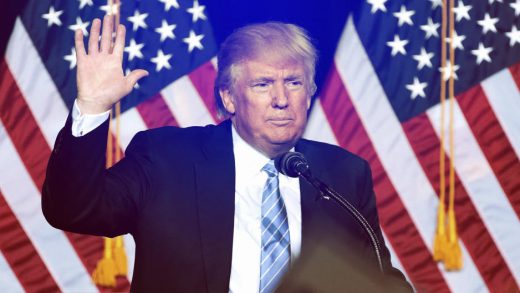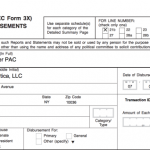Crunching The Numbers On Trump’s Plan To Deport Immigrants
Donald Trump said a lot about immigration reform during his campaign. But transitioning Trump’s stump speech zingers into actual policies in 2017 could prove very costly for the country, experts say.
Trump is still saying he will build a wall on the border with Mexico. He has said he would remove all unauthorized immigrants from the U.S. He now says he’ll focus on removing or jailing only unauthorized immigrants with criminal records. Just this week, Kansas Secretary of State Kris Kobach, a member of the Trump transition team, was photographed holding a memo that suggests enforcing the capture of illegal immigrants currently residing in the U.S. and details of building the border wall.
Here are Trump’s actual words from a 60 Minutes interview that aired on November 13:
“What we are going to do is get the people that are criminal and have criminal records, gang members, drug dealers, where a lot of these people, probably 2 million, it could be even 3 million, we are getting them out of our country or we are going to incarcerate.”
Doing The Math Of Illegal Immigrants
Trump’s estimate of two million to three million people has been called into question. It’s probably based at least in part on a Department of Homeland Security report to Congress in 2012 that estimated there were roughly 1.9 million illegal immigrants with criminal records in the country at the time who could be deported.
“His figures bear no relation to reality,” says immigration expert Stephen Legomsky, a professor at the Washington University School of Law in St. Louis. “It’s based on ICE [U.S. Immigration and Customs Enforcement] data from almost five years ago.” Legomsky points out that some of the people included in that estimate were those already in prison, people whose whereabouts are unknown, and people who are in the country legally with green cards.
Legomsky says a certain number of them were in the country illegally and have criminal records, “but those are the people Obama has already gone after. Deporting those people is the current policy.” President Obama was aggressive about deporting illegal immigrants in his first term, earning himself the moniker “Deporter in Chief.”
In his second term, Obama deprioritized illegal immigrants with no criminal records, but has continued to pursue those with criminal records. According to ICE figures, the Department of Homeland Security deported 1,454,301 illegal immigrants with criminal records in the years between 2008 and 2015.
So you have to subtract all the people Obama deported during his second term from ICE’s 2012 figure of 1.9 million persons, Legomsky points out. And of course, more illegal immigrants with criminal records probably came into the country since 2012.
According to 2015 estimates from the nonpartisan, nonprofit think tank Migration Policy Institute (MPI), the actual number of unauthorized immigrants with criminal records was about 820,000. And a good chunk of them don’t sound like the “bad hombres” Trump describes.
The MPI states that of those estimated 820,000 immigrants with criminal records in the country now, only about 300,000 are felons. Another 390,000 have serious misdemeanors that resulted in more than 90 days of jail time. The rest are people with even less serious misdemeanors, such as unpaid parking tickets or jaywalking citations.
The Cost Of Deportation
Even if Trump could find 3 million unauthorized immigrants with criminal records in the county, it’s not clear that it would be a good idea to remove them.
The costs of deporting undocumented aliens with criminal records is considerable. The Center for American Progress (CAP), a public policy research organization, says “interior removal” will cost, on average, $10,070 per immigrant. This, the group says, includes the cost of capturing the person, detaining them, processing them through the immigration courts, and physically removing them from the country. So deporting up to 3 million people adds up to a cost of between $20.1 and $30.2 billion, according to the CAP’s individual estimates.
The overall economic impact of removing those people is hard to peg, but it could be considerable. “It is likely that a good portion of those who will be removed will be people working in the economy, and that means sucking workers out of jobs,” says Phil Wolgin, CAP’s managing director of immigration policy.
Alec Levenson, a labor economist at the University of Southern California’s Marshall School of Business, says deporting undocumented immigrants with criminal records could have both positive and negative effects on the economy.
“When you have a large number of people coming in who are working in similar kinds of jobs as the people who are already here, there’s evidence that it can make it a little harder for those people who are already here,” he says.
It all depends on the job. “We tend to look down on people who have criminal records,” Levenson notes, “but those people may be more willing to take work that others might not want to take, because they have a harder time finding employment.”
Levenson says that the impact of illegal immigrants isn’t that much different from other immigrant groups. “Just because someone has a criminal record doesn’t mean they are a total drain on society from an employment perspective,” he says.
Economic Challenges
There are also political difficulties associated with deporting 3 million immigrants. Congress grants enough resources to the Department of Homeland Security to deport roughly 400,000 people each year. Trump would have to convince Congress to increase those resources dramatically to put 2 million to 3 million people out of the country immediately. He may first have to prove that there are that many in the country.
Trump said in the 60 Minutes interview that after undocumented immigrants with criminal records are deported, his administration will work out a plan for dealing with undocumented aliens with no criminal records.
CAP believes the total number of unauthorized immigrants in the U.S. at the end of 2015 was approximately 11.3 million, or about 3.5% of the total U.S. population at that time. The group also estimated that of the 11.3 million total, about 7 million were workers.
The removal of those 7 million workers would immediately reduce GDP by 1.4%, CAP estimates, and would reduce cumulative GDP over 10 years by $4.7 trillion.
In a report earlier this year, the American Action Network, a nonprofit issue advocacy group based in Washington, D.C. which promotes center-right public policy, revealed a similar cost. They wrote:
“The federal government would have to spend roughly $400 billion to $600 billion to address the 11.2 million undocumented immigrants and prevent future unlawful entry into the United States. In order to remove all undocumented immigrants, each immigrant would have to be apprehended, detained, legally processed, and transported to his or her home country. In turn, this would shrink the labor force by 11 million workers and reduce real GDP by $1.6 trillion.”
Fast Company , Read Full Story
(36)














